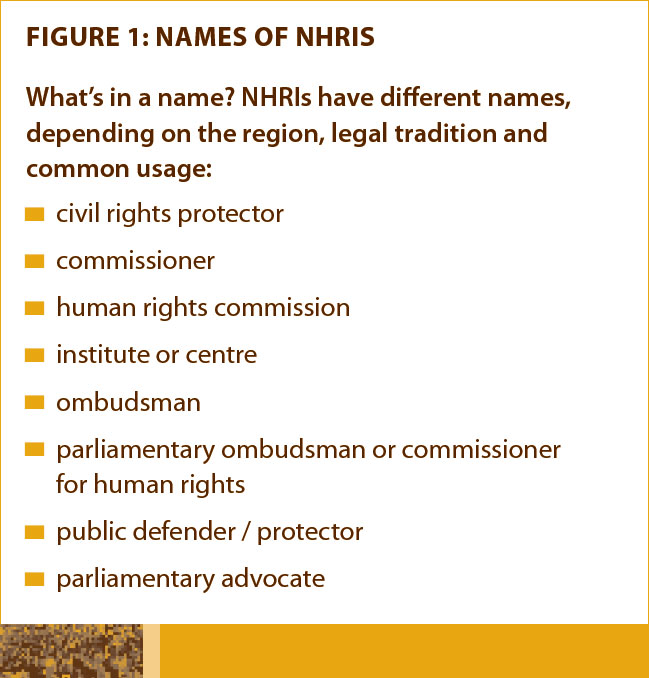2.1 Different Approaches: Form and Function
There is no ideal or single accepted structure for NHRIs, beyond compliance with the Paris Principles. The Principles do not impose a uniform model for carrying out these responsibilities and exercising these powers. The best strategy for working effectively with an NHRI – or helping to establish one – is to understand the surrounding legal, political and regional institutional culture or the country and region.
How one categorises a NHRI will depend greatly on regional practice and accepted terminology from a legal or structural perspective, as well as what functions the NHRI will have.
Historically, the distinctions are made between institutions that are “Ombudsman-like” and institutions Commissions. As a generality, Ombudsman institutions were headed by a single person, used moral persuasion rather than legal enforcement, and applied to public sector activity only.
- Commissions, on the other hand, tended to be a more representative group, with several members, and could have enforcement powers to deal with abuses and could apply to both the public and private sector. Given the evolution in the development of institutions, and in the nature and function of Ombudsman institutions, this twofold distinction is not very helpful.
Legal and Structural Approach
The Paris Principles help to ensure a minimum set of standards and therefore that NHRIs share certain similarities as regards powers and responsibilities. Moreover, even though institutions may share certain similar core responsibilities, the emphasis they put on these may differ markedly. Some institutions may emphasise their advisory, monitoring or promotion function, for example, while others may put a greater emphasis on investigation. Nonetheless, it is possible to distinguish between the national institutions that have been accredited by the international network of national institutions and to categorise them as being of one type or another, if at times somewhat imperfectly.
- If one looks at legal tradition, particular models tend to be found in certain regions. In the International Council on Human Rights Policy’s publication “Assessing the Effectiveness of National Human Rights Institutions”, NHRIs are described as being in the “Hispanic, Francophone or Commonwealth tradition”, or as being organised by continent: “multi-member institutions that receive complaints in most of Africa and Asia, single-member Defensores del pueblo in Latin America, Ombudsman [offices] in European Nordic countries, and advisory institutions in Europe”.1 These divisions reflect regional differences to some extent, but there is often great variety within regions.
- If one looks at structure, one might refer to institutions being either “ombudsman-like” or “commission-like”, depending on whether the organisation is structured around a single person or office-holder, or based on the more corporate and multi-member structure of a commission. Commonwealth of Independent States (CIS) countries, for example, tend to favour an ombudsman style model.
- Even so, care should be taken because classifications are at best approximate, and the names can be misleading: the fact that a “commission” usually investigates complaints does not prevent a purely advisory body from calling itself a “commission”. Similarly, some commissions are, in fact, structured as ombudsman offices - the Mexican Human Rights Commission, for example. Some ombudsman-style offices have multiple deputy ombudsmen, much like a commission, etc.
- While there are many different names for NHRIs (see Figure 1: Names of NHRIs), the name itself is of little consequence provided that it clearly communicates to the public (1) what the NHRI does and (2) the fact that it is a public institution and not an NGO. For example, it has been noted in one country that the name “Centre for Human Rights” for a NHRI is misleading because it sounds like a NGO.
- Your best guide is always the enabling statute of the institution, which sets out the powers and functions of the institution.
- If one looks at powers and functions, there is a range, or continuum, of powers consistent with being Paris Principle compliant, including institutions that are:
- headed by a single individual or by a more representative body of members;
- able to undertake investigations and make recommendations;
- “quasi-jurisdictional”, with the power to receive individual complaints and to render decisions with binding effect, or that enforce decisions through the courts or specialised tribunals;
- Is responsible for the concerns of a single group of people or a single issue, or has a wider mandate, and finally?;
- Has authority over human rights concerns only, or can deal with other matters such as those more usually understood as belonging to a classic Ombudsman such as maladministration?
These and other examples and approaches show that the line between NHRIs and other types of national bodies is starting to blur, and disagreements about the “proper” model are not productive beyond the minimum criteria set by the Paris Principles. Because of the practical nature of this Toolkit, we have chosen to address areas of classification from a functional and pragmatic perspective, while at the same time mentioning legal and structural issues, including regional specificities.
